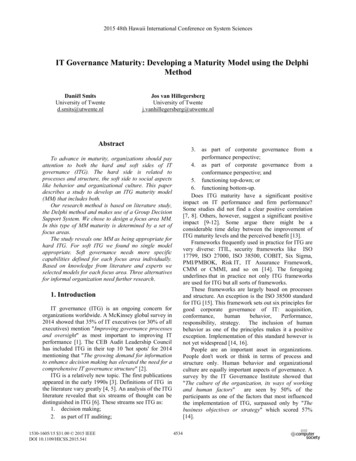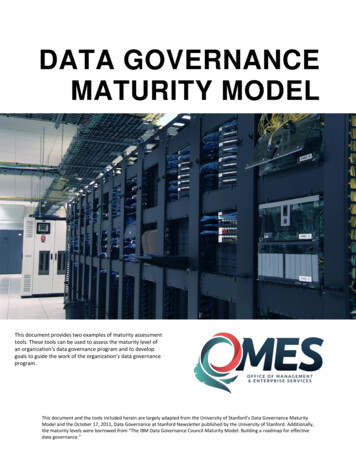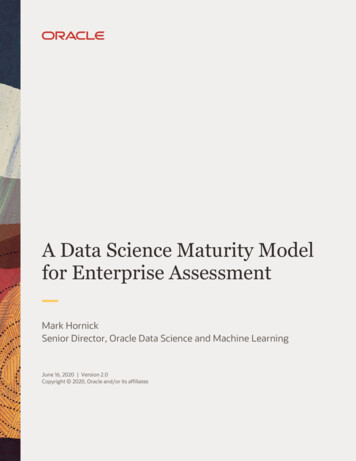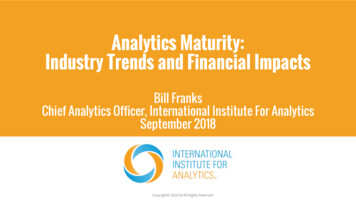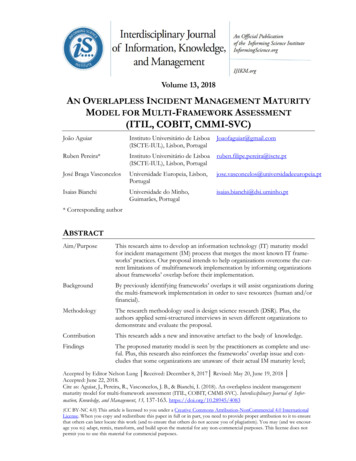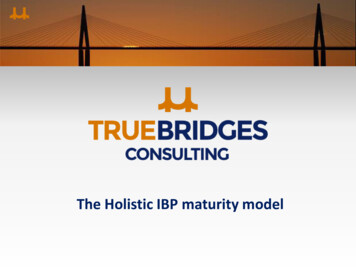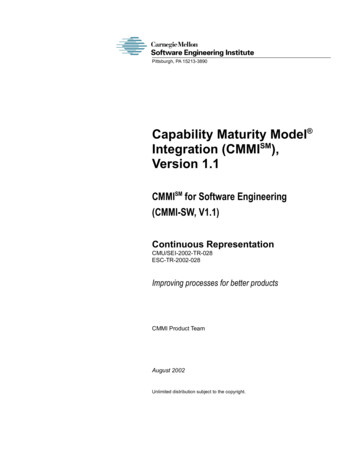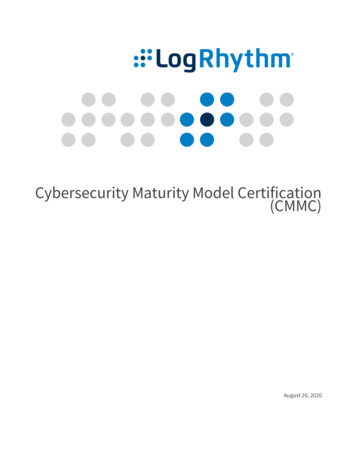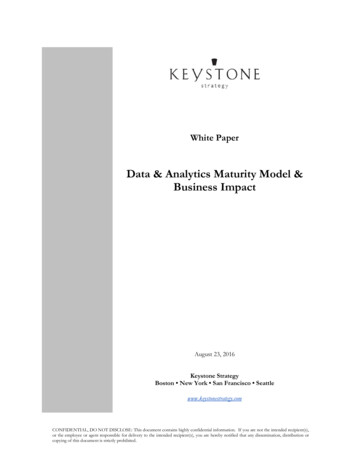
Transcription
White PaperData & Analytics Maturity Model &Business ImpactAugust 23, 2016Keystone StrategyBoston New York San Francisco Seattlewww.keystonestrategy.comCONFIDENTIAL, DO NOT DISCLOSE: This document contains highly confidential information. If you are not the intended recipient(s),or the employee or agent responsible for delivery to the intended recipient(s), you are hereby notified that any dissemination, distribution orcopying of this document is strictly prohibited.
Table of Contents1.2.3.Executive Summary . 3Methodology . 4Data & Analytics Maturity Model & Business Impact . 5A. Data & Analytics Driving Business Performance . 5B.Data as a Strategic Asset . 6C.Data & Analytics Enabling Business Operations . 81. Sales & Marketing . 92. Engineering & Operations. 93. Risk & Fraud . 104. Finance, HR & Back-Office . 114. Data & Analytics Evolution . 11A. Comparison of the Data Platforms of Leading & Lagging Enterprises . 11B.5.6.Data & Analytics Journey . 12Data & Analytics Maturity Model as a Guide for Roadmap Planning . 16A. Data & Analytics Maturity Model Overview. 16B.Maturity Levels by Data Platform Product Area . 16A.Appendix: Data & Analytics Maturity Model Case Examples. 19Online Furniture Retailer . 19B.C.1.2.3.4.Company Overview . 19Business Use Cases and Data Pipeline . 19Data & Analytics Maturity Assessment . 20Future Plans . 21Industrial Conglomerate . 211.2.3.4.Company Overview . 21Business Use Cases and Data Platform Roadmap . 22Data & Analytics Maturity Assessment . 22Future Plans . 23Property & Causality Insurer . 241. Company Overview . 242. Business Use Cases and Data Platform Roadmap . 243. Data & Analytics Maturity Assessment . 244. Future Plans . 25D. Toy manufacturer . 261.2.3.4.Company Overview . 26Business Use Cases and Data Platform Roadmap . 26Data & Analytics Maturity Assessment . 27Future Plans . 28Page 2 of 28CONFIDENTIAL, DO NOT DISCLOSE: This document contains highly confidential information. If you are not the intended recipient(s),or the employee or agent responsible for delivery to the intended recipient(s), you are hereby notified that any dissemination, distribution orcopying of this document is strictly prohibited.
1.Executive SummaryThe importance of “Big Data” to modern enterprises has drawn extensive coverage. Business leaders,technology analysts, the press, and the investment community have discussed how data is transformingbusiness, work and society. Data has been heralded as nothing less than “the new raw material ofbusiness: an economic input almost on par with capital and labor.”1Amid the discussion of how data, business intelligence, and analytics are reshaping business, the concretebenefits of data and analytics have been disputed. Do large IT budgets translate into higher businessperformance? Can enterprises unlock the potential of data in the same way as hyper-scale internetcompanies whose very business models are often reliant on Big Data, millions of connected devices, andsophisticated software platforms and algorithms? What concrete business value does data have forenterprises in traditional industries like manufacturing, consumer packaged goods, financial services, andretail?This white paper investigates the relationship between Data & Analytics technologies and businessperformance based on a large empirical study of major enterprises. To quantify the impact of data onbusiness performance, Keystone Strategy developed a Data & Analytics maturity index to grade whatcompanies can actually do with their data and their data platform. Companies were ranked based on thecapabilities they have deployed in their business and then compared and contrasted in terms of businessresults they have achieved. This study evaluated whether companies who have sophisticated Data &Analytics capabilities also have better business performance.The results are startling. The research found that Data & Analytics technologies are crucial for thesecompanies: Enterprises who have realized advanced data capabilities are found to outperform their peerson measures of profitability and employee productivity. Companies who have developed the mostsophisticated Data & Analytics platforms and apply these capabilities as a regular part of their businessenjoy operating margins that are eight percentage points higher than lagging organizations. Thistranslates to 100 million in operating profits on average for the more advanced companies in the samplecontrolling for factors such as company size and industry vertical.In addition to having superior financial results, companies with top Data & Analytics capabilities alsohave business processes that are more sophisticated than their peers. Top performing enterprises have“Data, data everywhere.” The Economist 25 February 2010. Web. 24 June 2016.http://www.economist.com/node/155574431Page 3 of 28CONFIDENTIAL, DO NOT DISCLOSE: This document contains highly confidential information. If you are not the intended recipient(s),or the employee or agent responsible for delivery to the intended recipient(s), you are hereby notified that any dissemination, distribution orcopying of this document is strictly prohibited.
used data to transform how their business operates across sales and marketing, engineering, operations,finance, HR, and back-office. These business functions of top performers look dramatically different asa result of the way they store, process, and use data to make more effective and real-time decisions.This paper profiles the capabilities and technical roadmaps applied by the Data & Analytics leaders andpresents a framework to assist companies in planning their strategy. Using the Data & Analyticscapabilities framework and online assessment tool (see: www.microsoft.com/datamaturity ),organizations can assess their current capabilities and determine how they rate relative to industry peers.The framework also offers a pattern for how enterprises can advance their Data & Analytics capabilitiesacross six product areas key to a modern data platform: Operational Databases, Enterprise DataWarehouse, Enterprise Data Lake, Business Intelligence, Advanced Analytics, and Cloud ComputingInfrastructure.2.MethodologyThe findings in this paper are based on primary research Keystone Strategy conducted as to how majorenterprises apply Data & Analytics within their business and use data to guide their business operations.Keystone conducted 344 one-hour long telephone interviews with senior business and technologydecision makers to profile the technologies enterprises have deployed and assess the business andtechnical capabilities in place to manage, analyze, and generate insight from data. This research focusedon upper midmarket and enterprise organizations, with a median company size of over 6000 employeesand 3.4B in company revenue. Organizations represented include companies in the manufacturing,consumer packaged goods, financial services, and retail industry verticals.Survey respondents answered approximately 150 closed-ended questions pertaining to their company’sbusiness, technologies deployed and Data & Analytics capabilities as well as their perceptions regardingdata’s strategic importance. To design the Data & Analytics capabilities framework, multiple inputs wereused including analyst reports and white papers, case studies and marketing materials of technologycompanies providing Data & Analytics solutions, and pilot interviews with industry leading companies.Ultimately, seventy-four questions pertaining to Data & Analytics capabilities were used to grade theorganization’s level of data platform sophistication. These questions span six technology areas, whichcover the most important elements of organization’s data platform: Operational Databases Enterprise Data Warehousing (EDW)Page 4 of 28CONFIDENTIAL, DO NOT DISCLOSE: This document contains highly confidential information. If you are not the intended recipient(s),or the employee or agent responsible for delivery to the intended recipient(s), you are hereby notified that any dissemination, distribution orcopying of this document is strictly prohibited.
Enterprise Data Lake (EDL) Business Intelligence (BI) Advanced Analytics Cloud Computing InfrastructureRespondents were grouped into quartiles based on the proportion of capabilities their organization hasin place (i.e., the percentage of capabilities questions they answered affirmatively). Organizations thatpossess the highest number of the Data & Analytics capabilities rated in the top quartile, whereas theleast sophisticated enterprises with the lowest number of capabilities rated in the lowest quartile.Keystone complemented the survey data with company profile and business performance metrics frompublic information sources and regulatory filings, S&P CapitalIQ, and Dun & Bradstreet.3.Data & Analytics Maturity Model & Business ImpactA.Data & Analytics Driving Business PerformanceThis study found that the enterprises with the most sophisticated Data & Analytics capabilitiesdemonstrate higher levels of corporate business performance when holding constant factors such asindustry vertical and company size. Enterprises within the top quartile have operating margins eightpercentage points higher than enterprises in the bottom quartile. This difference in operating marginstranslates to a difference of 100 million per year in operating profit, controlling for company size andindustry vertical.“Nobody envisioned that data and analytics could provide this sort of value to our business.It’s not a question of where we should apply data anymore, it’s a question of where we can gaininsights first.” Lead Technical Architect, 1 Billion Consumer Electronics FirmPage 5 of 28CONFIDENTIAL, DO NOT DISCLOSE: This document contains highly confidential information. If you are not the intended recipient(s),or the employee or agent responsible for delivery to the intended recipient(s), you are hereby notified that any dissemination, distribution orcopying of this document is strictly prohibited.
This research finds that organizations with leading Data & Analytics capabilities also out
Warehouse, Enterprise Data Lake, Business Intelligence, Advanced Analytics, and Cloud Computing Infrastructure. 2. Methodology The findings in this paper are based on primary research Keystone Strategy conducted as to how major enterprises apply Data & Analytics within their business and use data to guide their business operations.
